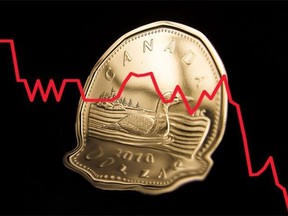This year has not been kind to the loonie, and it’s about to get worse
Article content
The Canadian dollar could be in for a rough ride if the Bank of Canada cuts interest rates sooner and deeper than the Federal Reserve, a scenario that economists suggest is becoming increasingly likely as the U.S. economy continues to outperform.
In a sign of what could come, the loonie fell more than a half per cent against the U.S. dollar in the wake of the Bank of Canada’s interest rate announcement last Wednesday, during which governor Tiff Macklem said a cut at the June rate meeting was now “within the realm of possibilities.”
Advertisement 2
Article content
Article content
That put the weakened loonie in the crosshairs of a stronger American currency and the Bank of Canada possibly at the mercy of a Federal Reserve that appears in no rush to start cutting.
“Pushing out Fed rate cuts makes it more difficult for the Bank of Canada to ease without causing CAD (the Canadian dollar) to crater,” Derek Holt, vice-president and head of capital markets economics at Bank of Nova Scotia, said in note to investors following the interest rate announcement.
“If there is one thing one needs to understand about Canada … it is very much the fact that it is not fully independent of the United States. Nor is the Bank of Canada fully independent of the Fed,” Holt said.
This year has not been kind to the loonie. So far, it is down slightly more than four per cent from mid-December, when it topped out at almost 76 cents US, and is currently at its lowest level since November.
“The Canadian dollar’s lacklustre performance against the U.S. dollar has been a notable curiosity in 2024, particularly given the recent spike in oil prices,” Stefane Marion and Kyle Dahms, economists at National Bank, said in an April note on the currency.
Article content
Advertisement 3
Article content
The pair are calling for the loonie to fall to 71 cents US in the third quarter and 70 cents US in the fourth quarter with Tuesday’s federal budget “a potential wildcard for the currency.”
Marion and Dahms attributed the Canadian dollar’s current weakness in part to the potential for “divergence in monetary policy” that would see the Bank of Canada cut rates more aggressively than its U.S. counterpart.
Any plans the Fed officials might have been harbouring for rate cuts got a jolt last week when fresh data showed the U.S. consumer price index rose by 3.5 per cent in March, topping analyst estimates. That led markets to trim calls for Federal Reserve cuts in 2024 to two from three, another step down from the four to five reductions investors had previously been predicting would begin in March.
“An added wrinkle for the BoC is the stickiness in U.S. inflation,” Benjamin Reitzes, Canadian rates and macro strategist at BMO Capital Markets, said in a note. Though the Bank of Canada may want to cut rates, Reitzes said it might find itself backed into a corner if it gets too far ahead of the Fed because the currency differential would effectively import inflation.
Advertisement 4
Article content
“While Canada can go it alone with cuts, there’s a limit to how far BoC/Fed policy rates can diverge as the loonie could weaken materially, which, in turn would work counter to bringing inflation back down to two per cent.”
That doesn’t mean diverging rates are fully off the table.
The Bank of Canada can cut rates one or two times before the Federal Reserve starts easing “without pushing the spread to uncomfortable levels,” Royce Mendes, managing director and head of macro strategy at Desjardins Group, said in a note, adding that there have been instances since 1996 when “the Bank of Canada’s policy rate has been 100 basis points or more below the Fed’s target policy rate.”
“We forecast that the spread will reach a maximum of 112.5 basis points during the upcoming easing cycle,” he said.
“In this environment I think CAD/USD could reach 0.72 in the near future and remain there for a little while,” Mendes said in an email.
In Canada, markets are predicting a 50/50 chance of a June rate cut. In a separate note, BMO Capital Markets said markets are only pricing in two more cuts this year outside of June.
Advertisement 5
Article content
Recommended from Editorial
-

The winners and losers as the loonie keeps flying south
-

Canadian dollar to ‘fade back’ on slowing economy
-

Outlook for Canadian dollar darkens in world of risks
In the long-run Canada’s inflation and affordability issues pose the most serious problems for the loonie, Jean-Francois Tardif, founder and portfolio manager at Timelo Investment Management, said in a recent interview with BNN Bloomberg.
Expensive housing will necessarily force people to push for higher wages, which in turn feeds into inflation. Further, a weaker economy compared to the U.S. in the form of negative GDP growth per capita makes Canada less attractive to foreign investors, weighing on the loonie.
Tardif said he could see the loonie “easily” falling to 50 cents US over time.
• Email: gmvsuhanic@postmedia.com
Bookmark our website and support our journalism: Don’t miss the business news you need to know — add financialpost.com to your bookmarks and sign up for our newsletters here.
Article content
Canadian dollar could ‘crater’ if Bank of Canada cuts more than Fed
2024-04-15 13:37:39








